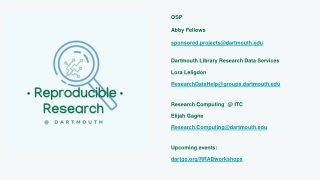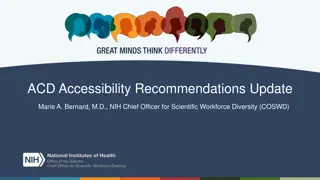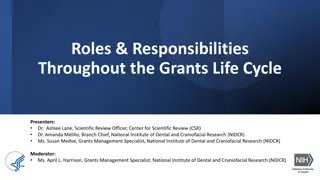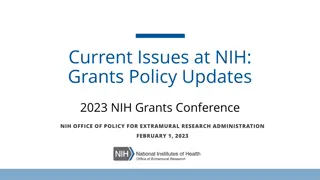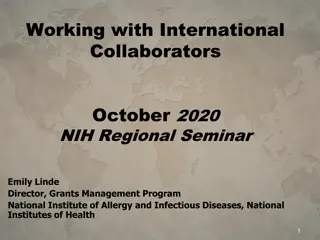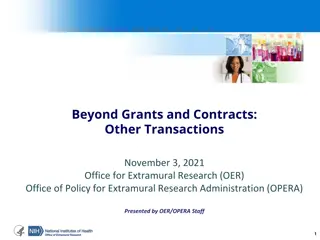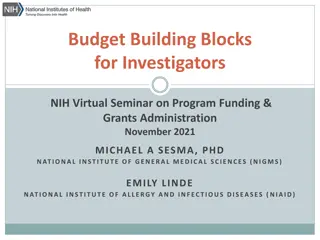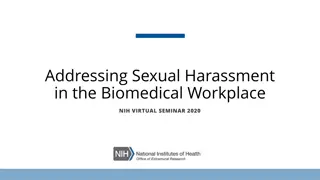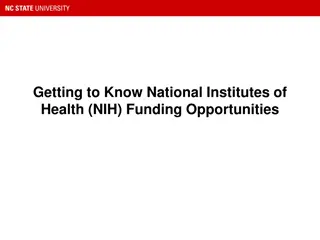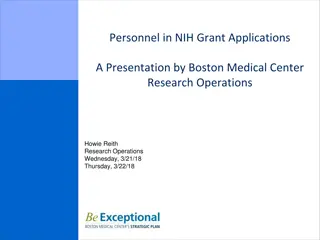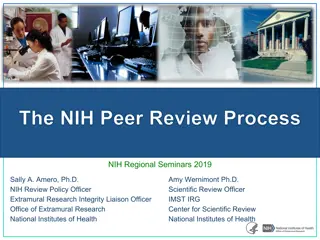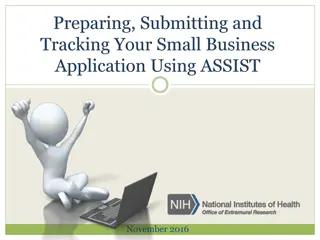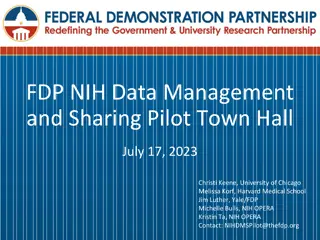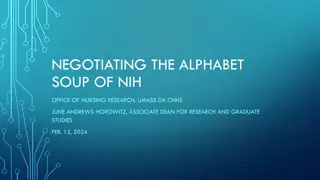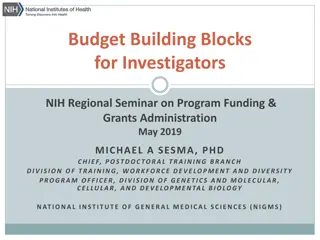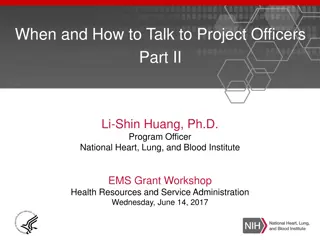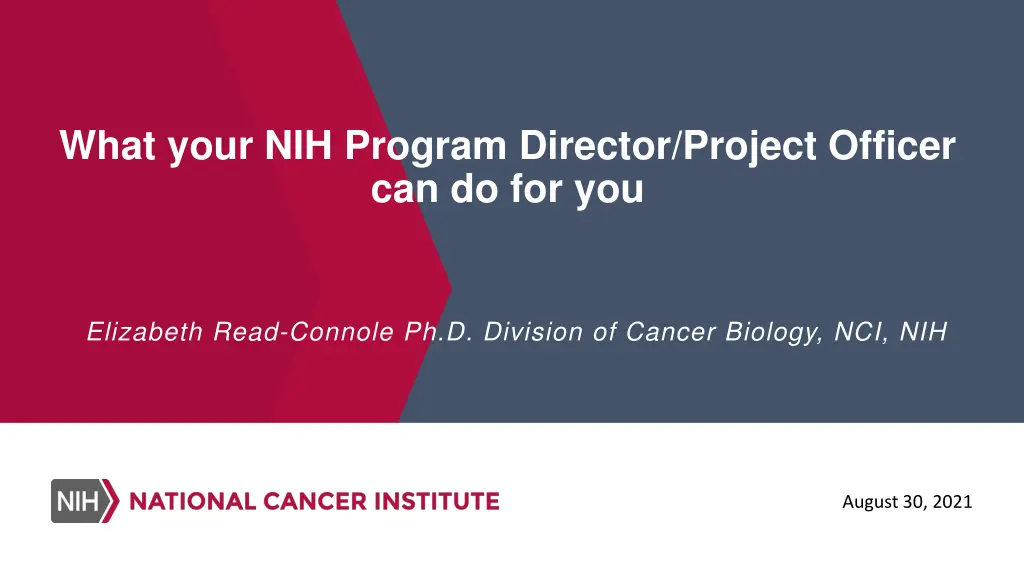
NIH Program Director Responsibilities for Cancer Research Grants
Learn about the roles and responsibilities of a Program Director/Project Officer at the NCI, including supporting cancer research, guiding funding opportunities, providing resources, and collaborating with researchers throughout the grant application process.
Download Presentation

Please find below an Image/Link to download the presentation.
The content on the website is provided AS IS for your information and personal use only. It may not be sold, licensed, or shared on other websites without obtaining consent from the author. If you encounter any issues during the download, it is possible that the publisher has removed the file from their server.
You are allowed to download the files provided on this website for personal or commercial use, subject to the condition that they are used lawfully. All files are the property of their respective owners.
The content on the website is provided AS IS for your information and personal use only. It may not be sold, licensed, or shared on other websites without obtaining consent from the author.
E N D
Presentation Transcript
What your NIH Program Director/Project Officer can do for you Elizabeth Read-Connole Ph.D. Division of Cancer Biology, NCI, NIH August 30, 2021
Topics 1. NCI Extramural Divisions 2. What Your NIH PD can do for You 3. Guidance 4. Funding Opportunities and How they are Developed 5. Resources 2
The NCI Extramural Divisions The NCI Extramural Divisions DIVISION OF CANCER BIOLOGY DCB encourages and facilitates continued support of basic research in all areas of cancer biology to provide the research foundation which enables improved understanding of the disease and may lead to new approaches for prevention, diagnosis, and treatment. DIVISION OF CANCER PREVENTION DCP conducts and supports research to find ways to prevent and detect cancer, and to prevent or relieve symptoms from cancer and its treatments. DIVISION OF CANCER CONTROL AND POPULATION SCIENCES DCCPS conducts and supports an integrated program of genetic, epidemiological, behavioral, social, applied, and surveillance cancer research to reduce risk, incidence, and deaths from cancer as well as enhance the quality of life for cancer survivors. DIVISION OF CANCER TREATMENT AND DIAGNOSIS DCTD supports the translation of promising research into clinical applications to improve the diagnosis and treatment of cancer in areas of unmet need that are often too risky or difficult for industry or academia to develop alone. DIVISION OF EXTRAMURAL ACTIVITIES DEA coordinates the scientific review of extramural research before funding and provides systematic surveillance of that research after awards are made to assist the NCI in achieving its goal of a balanced research portfolio. 4
Pre Pre- -Award Phase: Interaction of PD/PO with PI Award Phase: Interaction of PD/PO with PI 1. Early discussions about: ideas for an application, relevance to NCI mission, relevant funding mechanisms and study sections, when to apply, budget policies, the team, etc. 2. Listen to study section reviews for providing feedback on summary statements and potential next steps. 3. Advocate for your application if there are discretionary funds or if you applied to a specialized research program (e.g., cooperative agreements). 4. Help resolve pre-award issues such as concerns with scientific overlap, budget, human/animal subjects, foreign applications/components. 5. Work with GMS on administering grants: both the PD and the GMS must hit the GO button to award a grant. 6
Post-Award Phase: Interaction of PD/PO with PI Monitor progress of your research grant by keeping an eye out for your papers, touching base with you at scientific meetings and workshops, etc. Review, evaluate, and approve annual progress reports. Monitor compliance of regulations, policies, special terms of the award. Identify gaps/needs/opportunities and solve problems in the project throughout the grant life-cycle. Serve as point of contact for information about additional sources of funding (e.g., administrative supplements) and resources for your project and your lab. Report your major research advances to DCB colleagues and NCI/NIH leadership. 7
And Its a Two-Way Street: PI Responsibilities Update Personal Profile section of eRA Commons (e.g., name, degrees, institution, department, academic rank, address, phone number, email). Monitor status updates for applications and grants as they move through the system, via the Status section of eRA Commons. Documents received/accepted, study section assignment and SRO, NIH referral assignment, NIH PD, Score, Summary Statement, Just-in-Time (JIT) requests, Notice of Award (NoA), etc. Submit required materials on time: Just-in-Time info, Progress Report (RPPR), required certifications and documentation (e.g., IACUC, IRB, training certification, data sharing, resource sharing, genomic data sharing, grant close-out reports). Inform PD about major advances and publications no need to wait for next Progress Report (optional, but easy). 8
What NIH PD/POs cannot do for you Tell you how to do your project. Provide exemptions for submission deadline or rules-violation. Change a study section assignment. Change the NCI funding policy. Change the requirements that must be fulfilled for an award to be issued. Write you a letter of recommendation as your PD. Talk to your Chairperson, or anyone outside of NIH except you, about your application, your Summary Statement, or your job/position status. 9
Why would you talk with your NCI PD? NCI PD expertise can help strengthen your project and your science. Service: help the PI optimize the application, so reviewers can evaluate the best version, and NCI fund highly meritorious science. Stewardship: Ensure that the nation s investment in NCI is well-spent, in a legal and ethical manner. Vision: Be current and forward-looking about the big picture in our field, so we can help NIH leadership and PIs make decisions about how best to advance cancer research. SROs, PDs, and GMSs have a different balance of these three roles. Different PDs have a unique balance of these three roles, too. 10
3. NCI Funding Opportunities (FOA)s and How They are Developed 11
The NIH Common Fund The NIH Common Fund The NIH Common Fund (https://commonfund.nih.gov) A component of the NIH budget Managed by Office of Strategic Coordination/Division of Program Coordination, Planning, and Strategic Coordination/Office of the NIH Director. Common Fund programs address emerging scientific opportunities and pressing challenges in biomedical research that no single NIH Institute or Center can address on its own but are of high priority for the NIH as a whole. A unique resource at NIH, functioning as a venture capital space where high-risk, innovative endeavors with the potential for extraordinary impact can be supported. Short-term, goal-driven strategic investments, with deliverables intended to catalyze research across multiple biomedical research disciplines. Intended to change paradigms, develop innovative tools and technologies, and/or provide fundamental foundations for research that can be used by the broad biomedical research community. Active Funding Opportunities: https://commonfund.nih.gov/first/funding_opportunities 12
Common Fund Programs Common Fund Programs Common Fund Programs: https://commonfund.nih.gov/programs 13
NCI Active Funding Opportunities NCI Active Funding Opportunities Funding Opportunities Cancer Prevention, Detection, Diagnosis, and Treatment Technologies for Global Health (U01) Notice of Special Interest (NOSI): Use of Biological "High" or "Medium" Priority AIDS Research on Non-AIDS-defining or AIDS-defining Cancers (R03, R21, R01) Transmission of Kaposi Sarcoma-Associated Herpesvirus (KSHV) (RFA R01) HIV-associated Non-Communicable Diseases Research at Low- and Middle-Income Country Institutions (PAR R21) Multidisciplinary Studies of HIV/AIDS and Aging (PAR R21, R01) Harnessing Big Data to Halt HIV ( PAR R01) Reducing Stigma to Improve HIV/AIDS Prevention, Treatment and Care in Low- and Middle-Income Countries (R21) Mechanisms of Disparities in Chronic Liver Diseases and Cancer (R21, R01) 14
How is an NCI Funding Opportunity Announcement (FOA) How is an NCI Funding Opportunity Announcement (FOA) Developed? Developed? 1. NCI Staff will Convene a Workshop on the Topic 2. Ideas vetted within an NCI Division 1. Input or Partners from Other Divisions, Institutes, or Offices Partners sought 3. Develop a concept of the research questions to be addressed 4. Present to the NCI Leadership for approval 5. If a set aside for funds or a special review is requested, then present to NCI s Board of Scientific Advisors for approval 6. FOA is written and published by the NIH Guide 7. Applications selected for Funding often through a special funding Plan, which must be approved by NCI Leadership 15
4. Guidance or Assistance In Addition to Contacting Your Program Director 16
Guidance NIH Grants Information the Steps for Applying https://grants.nih.gov/grants/grants_process.htm Grants and Funding https://grants.nih.gov/funding/index.htm Sign up for weekly notifications (The NIH GUIDE) https://grants.nih.gov/grants/guide/listserv_dev.htm 17
5. Resources 18
NCIs Center to Reduce Cancer Health Disparities (CRCHD) Supplements to Promote Diversity in Health-Related Research 19
Centers for AIDS Research (CFAR) The 17 CFARs are co-funded by eleven NIH Institutes. 20
NCI Cancer Centers 71 NCI-Designated Cancer Centers, in 36 states and the District of Columbia, to deliver cutting- edge cancer treatments to patients. 13 are Cancer Centers 51 are Comprehensive Cancer Centers 7 are Basic Laboratory Cancer Centers 21
New Webinar Series https://www.globalhep.org/moving-hepatitis- discovery-elimination-nih-webinar-series Moving from Hepatitis Discovery to Elimination: NIH Webinar Series The NIH is committed to setting research priorities that advance progress toward viral hepatitis elimination. In addition to basic research to understand the molecular processes of viral hepatitis infection, NIH focuses on development of new vaccines, diagnostics, treatments and other interventions to prevent acute and chronic hepatitis infection and related disease. 2019, NIH released The Strategic Plan for Trans-NIH Research to Cure Hepatitis B for Development of Improved HBV Therapies. NIH also supports intramural and extramural research of the other causes of viral hepatitis- hepatitis A virus, Hepatitis C virus, Hepatitis D virus and hepatitis E virus. 2021 launch of the Viral Hepatitis National Strategic Plan for the United States: A Roadmap to Elimination 2021-2025 22
Thank you for your attention. Questions? (bconnole@mail.nih.gov) or Your Program Director/Project Officer

